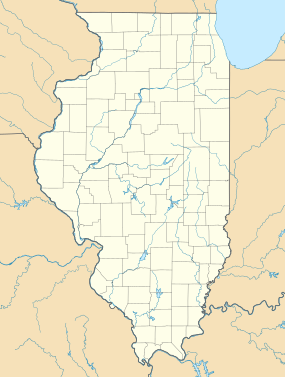Monk's Mound

Monks Mound in summer. The concrete staircase follows the approximate course of the ancient wooden stairs
|
|
| Location | Collinsville, Illinois, Madison County, Illinois, United States |
|---|---|
| Region | Madison County, Illinois |
| Coordinates | 38°39′38.4″N 90°3′43.36″W / 38.660667°N 90.0620444°W |
| History | |
| Founded | 900–950 CE |
| Cultures | Mississippian culture |
| Site notes | |
| Archaeologists | Thomas I. Ramey |
| Architecture | |
| Architectural styles | Platform mound |
| Responsible body: Illinois Historic Preservation Agency | |
Monks Mound is the largest Pre-Columbian earthwork in the Americas and the largest pyramid north of Mesoamerica. The beginning of its construction dates from 900-955 CE. Located at the Cahokia Mounds UNESCO World Heritage Site near Collinsville, Illinois, the mound size was calculated in 1988 as about 100 feet (30 m) high, 955 feet (291 m) long including the access ramp at the southern end, and 775 feet (236 m) wide. This makes Monks Mound roughly the same size at its base as the Great Pyramid of Giza (13.1 acres / 5.3 hectares). Its base circumference is larger than the Pyramid of the Sun at Teotihuacan. As a platform mound, the earthwork supported a wooden structure on the summit.
Unlike Egyptian pyramids which were built of stone, the platform mound was constructed almost entirely of layers of basket-transported soil and clay. Because of this construction and its flattened top, over the years, it has retained rainwater within the structure. This has caused slumping, the avalanche-like sliding of large sections of the sides at the highest part of the mound. Its designed dimensions would have been significantly smaller than its present extent, but recent excavations have revealed that slumping was a problem even while the mound was being made.
Construction of Monks Mound by the Mississippian culture began about 900–950 CE, on a site which had already been occupied by buildings. The original concept seems to have been a much smaller mound, now buried deep within the northern end of the present structure. At the northern end of the summit plateau, as finally completed around 1100 CE, is an area raised slightly higher still, on which was placed a building over 100 ft (30 m) long, the largest in the entire Cahokia Mounds urban zone. Deep excavations in 2007 confirmed findings from earlier test borings, that several types of earth and clay from different sources had been used successively. Study of various sites suggests that the stability of the mound was improved by the incorporation of bulwarks, some made of clay, others of sods from the Mississippi flood-plain, which permitted steeper slopes than the use of earth alone. The structure rises in four terraces to a height of 100 feet with a rectangular base covering nearly 15 acres and containing 22 million cubic feet of adobe, carried basket by basket to the site.
...
Wikipedia

